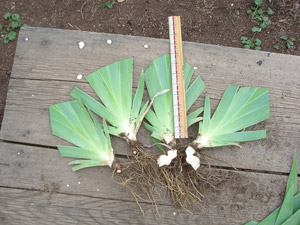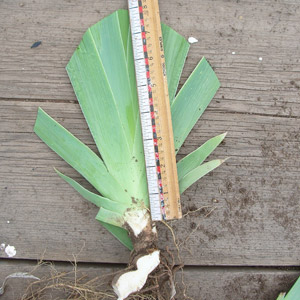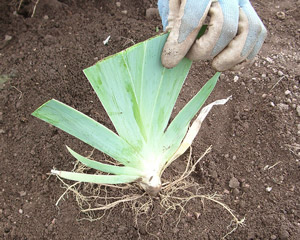WHERE TO PLANT
Iris will do their best when planted in well drained soil in an area that receives a minimum of a half day of sunlight. They usually don’t do well in planters or pots.
HOW TO PLANT
Iris plants are technically rhizomes, the rhizome being the enlarged fleshy underground stem from which the green leaves emerge above and the roots protrude below. Space plants from 12 to 20 inches apart, according to the room available. Plants spaced farther apart will not have to be divided as soon as the closer plantings. In planting, the rhizome should be set so the top is just below the surface of the ground. Roots should be spread out and sown to give a good anchor. Press soil firmly around the plant and water well to further consolidate the soil. Watering should be continued until the plant is well established. From then on, little supplemental irrigation is needed. Let the soil dry out between waterings.
CARE
Fertilizer can be worked into the soil before planting. Any complete fertilizer that is designed for vegetables or flowering plants is a good choice. Avoid fertilizer that is high in nitrogen, the first number in the formula, and look instead for something high in phosphorous, the second number. For example: 5-10-10, 15-30-15, 12-36-14, and 3-16-0 would all be acceptable formulations.
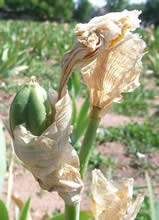
There is no need to trim iris leaves back except when transplanting. Brown leaves may be trimmed off and the area around the plants kept as weed-free as possible. Aphids may develop on iris leaves under certain conditions in the field or waiting for transplant. Simply wipe them off or use a gentle detergent spray to remove them.
Good sanitation becomes more important in humid climates to control fungus leaf spot and combat the major pest of iris in the eastern and mid-western states, the iris borer. The borer moths lay their eggs in the dead foliage in the fall so clean-up helps to break the cycle. So far the iris borer has not learned to live in the western states (fingers crossed it stays away). Aside from good sanitation there are some chemical controls and more recently there are reports of good control with beneficial nematodes that parasitize the larval and pupal stages of the borer. Read more here about eliminating iris borers.
It is a good idea to remove the bloom stalks after the flowers have faded. This prevents a seed pod from forming. If the bees have successfully pollinated the iris, you will notice a watermelon shaped seed pod just below the faded bloom a few weeks later. If this pod ripens, and the seed subsequently germinate, the resulting plant will most likely be very different from the beautiful parent. In this case, you have just become a reluctant hybridizer. Removing the bloom stalk prevents this and lets the plant build up strength for next year instead of using the energy to develop seeds. You may break off the stalks by hand or cut them off just above the rhizome.
TRANSPLANTING
About four years after planting, the clumps will need dividing. If not divided, the plant will eventually stop blooming. Transplanting may be done anytime after the bloom season, but should be completed before September.
BLOOM
Some iris will not bloom the first year after planting. In our short season climate the average bloom the first year is about 60%. Climatic variations will influence blooming. The bloom stalk is very tender and while still down in the leaf sheath can be injured by a late frost that has no effect on the rest of the plant.
Iris want to grow! Give them plenty of sun, a little food, don’t over water, keep the weeds away and they should reward you with beautiful bloom in the spring.
HOW TO PLANT IRIS CLUMPS
If you have purchased dig-it-yourself clumps or have established clumps in your own garden that need dividing, we suggest you follow these steps.
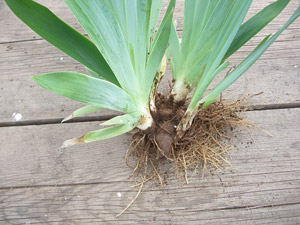
Iris Clump 
Divide the Clump
If more than 3 or 4 fans, divided the clump into 2 or more plants.
For best growth, if the plant is in bloom, cut off the bloomstalk (take it into the house, put it in water, and enjoy the buds as they open).
Leaves may be trimmed down to 8” to 12” in length. The foliage tends to turn yellow or brown from the shock of transplanting.
Plant in a good garden soil that is well drained. If needed, add fertilizer high in phosphorous. Just barely cover the rhizomes with soil.
Water thoroughly when planted, then about every week or 10 days until plant is well established. Let soil dry out between waterings.
Iris should have a minimum of a half day of sunlight and do well in full sun.

